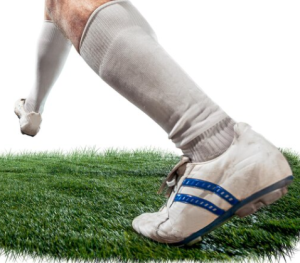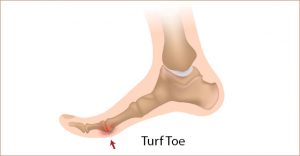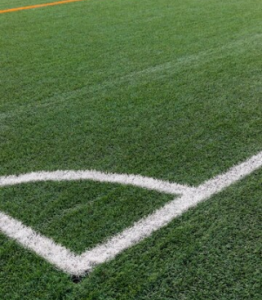
What is turf toe?

Turf toe is a type of sports injury that occurs in athletes with a lot of pushing off or changes in direction in their sport. Anatomically, turf toe is a hyperextension injury of the joint of the big toe. Essentially, the toe is forced past its normal range of motion. Unfortunately, this results in injury of the joint and tissues around it.
How does it happen?
The big toe is one of the most important joints for generating speed and power in our lower body. When we land on or push off from a surface, the big toe is often the first or last point of contact. As a result, it undergoes a high amount of force. Injury can happen due to:

- Sports with quick starts/stops and changes in direction: This happens in a lot of sports like basketball, football, soccer, lacrosse, field hockey, and more.
- Inappropriate footwear: Having a pair of ill-fitting or overly flexible shoes can increase the risk of the toe being hyperextended
- Type of terrain/playing surface: The name turf toe comes from increased chance of this injury occurring when playing on artificial turf.
What are the signs and symptoms?
- Pain around the big toe
- Big toe joint is sore and tender to the touch
- Pain with movement of the big toe or with pressure on it
- Joint may be swollen, red, bruised
- Difficulty walking or running
How is it treated?
In the acute stages, turf toe can be treated with the RICE principle and it is recommended and safe to start sports physiotherapy as soon as possible.
- RICE
- Rest: Modify your activities to include less weightbearing and avoid putting pressure on the joint as much as possible to give the joint time to heal
- Ice: For 24-48 hours after the injury, applying ice can help manage the pain, swelling, and inflammation in the area
- Compression: Applying compression to the injured toe can help limit the swelling in the joint.
- Elevation: Keeping the foot elevated as much as possible will help stop fluids from pooling in the leg and creating uncomfortable amounts of swelling
- Sports physiotherapy
- Physiotherapy is an essential part of getting you back to your sport as soon as possible and as safe as possible.
- Modalities: For example, ultrasound, cryotherapy, laser therapy, or electrotherapy may be used to help with tissue healing, inflammation, and pain relief.
- Manual Therapy: Your physiotherapist may use manual techniques like joint mobilizations, massage and more to help reduce stiffness, increase your range of motion, and reduce pain.
- Exercises: Eventually, when your joint has healed enough you can start exercises. Your physiotherapist will help you determine an appropriate place to start. Additionally, they will tailor the exercises to your specific sport, and assess your movements to see if there are any deviations that may be increasing your risk of injury.
- Back to play advice: Your physiotherapist will give you suggestions on how to go back to your sport safely. For example, you will not be able to jump back into play 100% at first, it may start by having you attend some shorter practices before eventually playing in some games.
Need help?
If you are experiencing a turf toe or any other kind of injury, look for PhysioNow! With locations across the GTA from Burlington, Oakville, Mississauga and Etobicoke, our expert physiotherapists are at your service. Book with PhysioNow today for your first assessment and treatment.



Leave a Reply